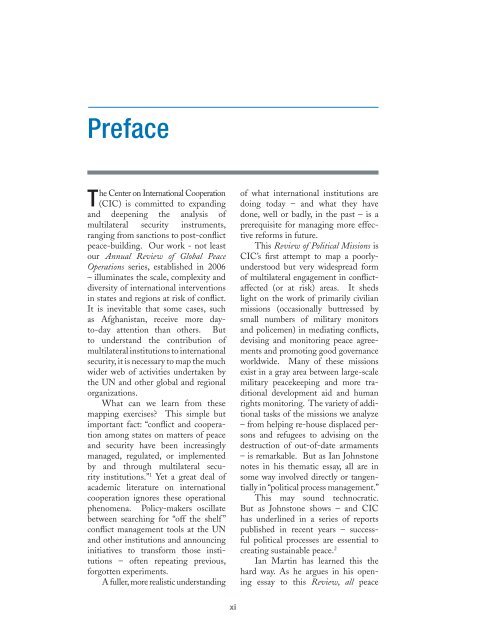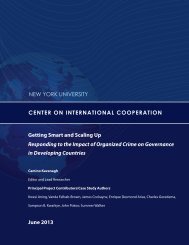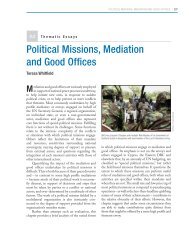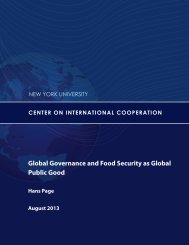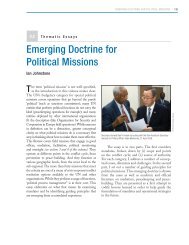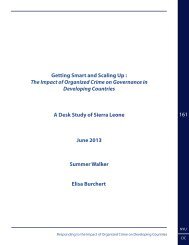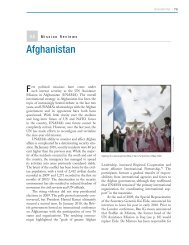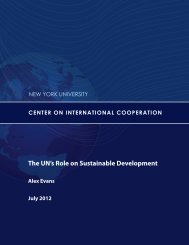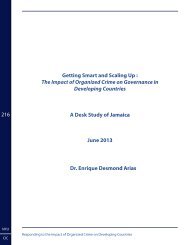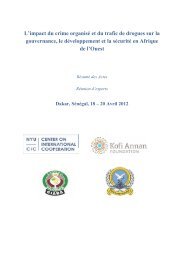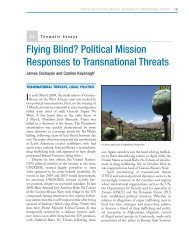here - Center on International Cooperation - New York University
here - Center on International Cooperation - New York University
here - Center on International Cooperation - New York University
Create successful ePaper yourself
Turn your PDF publications into a flip-book with our unique Google optimized e-Paper software.
PrefaceThe <str<strong>on</strong>g>Center</str<strong>on</strong>g> <strong>on</strong> Internati<strong>on</strong>al Cooperati<strong>on</strong>(CIC) is committed to expandingand deepening the analysis ofmultilateral security instruments,ranging from sancti<strong>on</strong>s to post-c<strong>on</strong>flictpeace-building. Our work - not leastour Annual Review of Global PeaceOperati<strong>on</strong>s series, established in 2006– illuminates the scale, complexity anddiversity of internati<strong>on</strong>al interventi<strong>on</strong>sin states and regi<strong>on</strong>s at risk of c<strong>on</strong>flict.It is inevitable that some cases, suchas Afghanistan, receive more dayto-dayattenti<strong>on</strong> than others. Butto understand the c<strong>on</strong>tributi<strong>on</strong> ofmultilateral instituti<strong>on</strong>s to internati<strong>on</strong>alsecurity, it is necessary to map the muchwider web of activities undertaken bythe UN and other global and regi<strong>on</strong>alorganizati<strong>on</strong>s.What can we learn from thesemapping exercises? This simple butimportant fact: “c<strong>on</strong>flict and cooperati<strong>on</strong>am<strong>on</strong>g states <strong>on</strong> matters of peaceand security have been increasinglymanaged, regulated, or implementedby and through multilateral securityinstituti<strong>on</strong>s.” 1 Yet a great deal ofacademic literature <strong>on</strong> internati<strong>on</strong>alcooperati<strong>on</strong> ignores these operati<strong>on</strong>alphenomena. Policy-makers oscillatebetween searching for “off the shelf ”c<strong>on</strong>flict management tools at the UNand other instituti<strong>on</strong>s and announcinginitiatives to transform those instituti<strong>on</strong>s– often repeating previous,forgotten experiments.A fuller, more realistic understandingof what internati<strong>on</strong>al instituti<strong>on</strong>s aredoing today – and what they haved<strong>on</strong>e, well or badly, in the past – is aprerequisite for managing more effectivereforms in future.This Review of Political Missi<strong>on</strong>s isCIC’s first attempt to map a poorlyunderstoodbut very widespread formof multilateral engagement in c<strong>on</strong>flictaffected(or at risk) areas. It shedslight <strong>on</strong> the work of primarily civilianmissi<strong>on</strong>s (occasi<strong>on</strong>ally buttressed bysmall numbers of military m<strong>on</strong>itorsand policemen) in mediating c<strong>on</strong>flicts,devising and m<strong>on</strong>itoring peace agreementsand promoting good governanceworldwide. Many of these missi<strong>on</strong>sexist in a gray area between large-scalemilitary peacekeeping and more traditi<strong>on</strong>aldevelopment aid and humanrights m<strong>on</strong>itoring. The variety of additi<strong>on</strong>altasks of the missi<strong>on</strong>s we analyze– from helping re-house displaced pers<strong>on</strong>sand refugees to advising <strong>on</strong> thedestructi<strong>on</strong> of out-of-date armaments– is remarkable. But as Ian Johnst<strong>on</strong>enotes in his thematic essay, all are insome way involved directly or tangentiallyin “political process management.”This may sound technocratic.But as Johnst<strong>on</strong>e shows – and CIChas underlined in a series of reportspublished in recent years – successfulpolitical processes are essential tocreating sustainable peace. 2Ian Martin has learned this thehard way. As he argues in his openingessay to this Review, all peacexi


